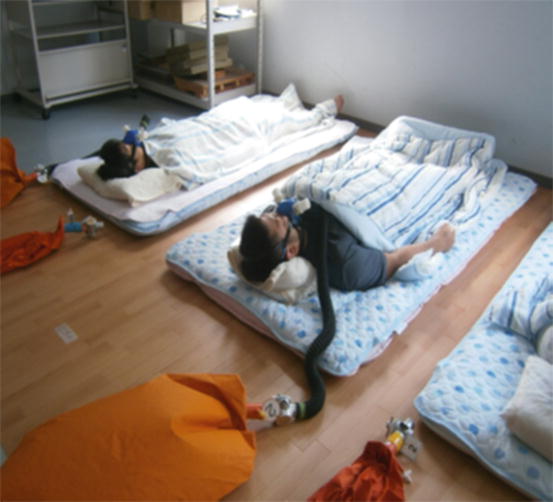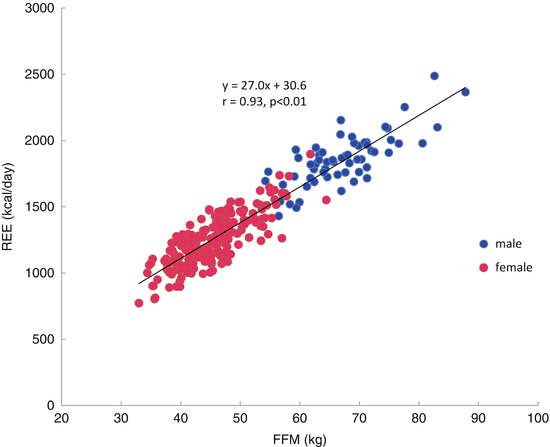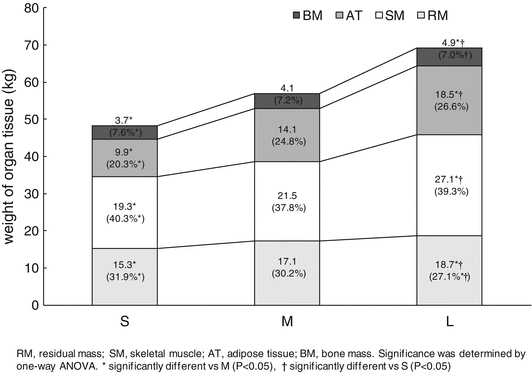Primary author
Year
Subjects, number
Sex
Weight (kg)
FFM (kg)
Gas collection device
REE
(kcal/day)
(kcal/kgBW/day)
(kcal/kgFFM/day)
Taguchi M
2001
16 runners
Female
48.2 ± 4.1
40.1 ± 2.8
Douglas bag
1,246 ± 121
26.0 ± 3.1
29.1 ± 3.8
8 rowers
Female
57.0 ± 5.6
46.5 ± 3.5
Douglas bag
1,351 ± 170
23.9 ± 3.9
30.6 ± 3.5
Takahashi E
2008
42 athletes in various sports
Female
58.9 ± 5.8
47.2 ± 4.2
Douglas bag
1,311 ± 138
22.3 ± 2.1
27.8 ± 2.5
Taguchi M
2010
21 endurance athletes
Female
54.2 ± 7.0
43.1 ± 3.9
Douglas bag
1,214 ± 161
22.5 ± 3.0
28.0 ± 3.5
40 athletes in strength and sprint-type sports
Female
56.1 ± 7.2
45.2 ± 4.0
Douglas bag
1,238 ± 184
22.2 ± 3.0
27.4 ± 3.4
20 ball-game athletes
Female
61.0 ± 8.0
48.3 ± 4.7
Douglas bag
1,322 ± 207
21.9 ± 3.0
27.6 ± 3.5
Taguchi M
2011
93 athletes in various sports
Female
57.0 ± 9.2
45.4 ± 6.2
Douglas bag
1,258 ± 202
22.1 ± 2.2
27.7 ± 2.6
Taguchi M
2011
122 athletes in various sports
Female
57.2 ± 7.9
45.4 ± 5.2
Douglas bag
1,242 ± 190
Not available
Not available
Oshima S
2011
42 American football and 15 handball players
Male
78.4 ± 11.5
67.0 ± 8.1
Douglas bag
1,856 ± 225
23.8 ± 1.8
27.8 ± 1.9
Tatsuta W
2012
29 elite athletes in various sports
Male
74.7 ± 12.8
64.9 ± 9.3
Douglas bag
1,896 ± 235
25.7 ± 3.2
29.4 ± 3.0
Oshima S
2013
37 American football players
Male
81.2 ± 11.3
67.7 ± 7.4
Douglas bag
1,869 ± 230
23.2 ± 2.0
27.7 ± 1.9
Currently, in the area of sports nutrition the equation being used to estimate energy requirements is based on the REE. Therefore, the REE has a large impact on the dietary management programs being used with athletes. In this chapter we briefly review the research utilized to estimate the REE of Japanese athletes. We will include some of our recent work in this area. Later in the chapter we employ these findings to construct a dietary management program for athletes.
11.2 Measurement of REE
In order to accurately measure REE, a number of conditions need to be met. These conditions are generally similar in different studies, but the details may differ to some degree. The following are the conditions utilized in our studies of REE: The subjects are instructed to fast and refrain from exercise for 12 h before measurements are taken. Athletes are asked to minimize any exertion prior to the laboratory visit in the early morning. REE is measured by indirect calorimetry using a Douglas bag. Athletes remain awake in the supine position at a comfortable room temperature (20 °C–25 °C). After a 30 min habituation period with the mask, two samples of expired gas are collected in Douglas bag for 10 min each and the mean value of the two samples is used for analysis (see Fig. 11.1). Oxygen and carbon dioxide concentrations are analyzed using a gas analyzer, and the volume of expired gas is determined using a dry gas volume meter. Then, REE is calculated using Weir’s equation (Weir 1949). Time variability in the REE of the subjects is less than 5.0 % as measured by the mean coefficient of variance (Compher et al. 2006).


Fig. 11.1
Depiction of the measurement of REE utilizing Douglas bags as the subject rests on Japanese-style bedding
11.3 Factors That Influence REE for Japanese Athletes
11.3.1 Body Size and Composition
In Japanese non-athletic subjects, Ganpule et al. (2007) reported that body weight (BW) accounted for 65–75 % of the variation in metabolic rates. Fat-free mass (FFM), however, is a more valid predictor of REE than BW because there was a higher association between FFM and REE than the association between BW and REE. The data of Ganpule et al. demonstrated that FFM accounted for 84–89 % of the variation in sleeping metabolic rate. Such a value is higher than other studies had previously reported (Ravussin and Bogardus 1990; Toubro et al. 1996; Weyer et al. 1999; Ganpule et al. 2007).
On the other hand, in athletes, body size and body composition vary widely among different types of sport and different weight classes. For example, for sports in which the BW must be moved over a long distance, such as distance running, a lean physique with small body size can provide a competitive advantage. On the other hand, heavyweight judo wrestlers and shot putters gain a great deal of competitive advantage through having a large frame with a higher volume of FFM. However, the relationship between the REE of athletes over a wide range of body size and composition has not been investigated thoroughly in previous studies.
Therefore, we performed an investigation in this area and found a significant correlation (r = 0.93, p < 0.01) between FFM and REE of Japanese male (n = 60) and female (n = 205) athletes as shown in Fig. 11.2. Taguchi et al. (2010) reported that the most powerful predictor of REE in female athletes by a multiple-regression analysis was FFM (45 % contribution) for different types of sports. Oshima et al. (2013) also reported that 69.7 % of variance of REE of male athletes could be explained by FFM (n = 37).


Fig. 11.2
The relationship between FFM and REE in Japanese athletes
In order to better understand the relationship between REE and body composition for athletes of different body size, we looked more closely at body composition, and focused on the organ-tissue level, and especially on FFM. In this study the subjects were 57 male athletes and 81 female athletes with a wide distribution of body size. Body composition was measured by dual energy X-ray absorptiometry (DXA), and FFM was calculated based on BW and % body fat. The subjects were classified into three groups according to their BW : small-size athletes (<mean BW–0.5SD), medium-size athletes (mean BW ± 0.5SD), and large-size athletes (>mean BW + 0.5SD). The bone mineral content (BMC) of the whole body and appendicular lean soft tissue (ALST) were also measured by DXA. Organ tissue mass was calculated using the prediction model of Usui et al. (2012). Bone mass (BM) was calculated as BMC times 1.85 (Heymsfield et al. 1990). Adipose tissue mass (AT) was calculated as fat mass (FM) times 1.18 (Snyder et al. 1975; Heymsfield et al. 2002). Skeletal muscle mass (SM) was calculated using the prediction model of Kim et al. (2002). Finally, residual mass (RM) was calculated as the difference between BW and the sum of the calculated BM, AT, and SM. This can be express as follows:


The absolute and relative values of the four organ-tissue level compartments increased significantly in accordance with body size as shown in Fig. 11.3. As expected, absolute REE (kcal/day) increased significantly in accordance with body size. However, if REE was adjusted by FFM (kcal/kg FFM/day), the REE/FFM was not different regardless of BW.


Fig. 11.3
Four organ tissue compartments expressed as weight and as their respective fractional contributions to body weight
FFM is not a single homogenous metabolic compartment (Gallagher et al. 1998; Illner et al. 2000). RM and SM are high metabolic components. The metabolic rates of these organs are 54 kcal/kg and 13 kcal/kg, respectively. Whereas, BM and AT are low metabolic components (2.3 and 4.5 kcal/kg/day, respectively). Estimated REE (REEe) from the specific metabolic rates of four major organ-tissue level compositions was compared with measured REE (REEm). There was good agreement between REEe and REEm (r = 0.77, p < 0.01).
Taken together, these results, in athletes, show that REE increases in accordance with increases in body size, and that there is a majorly influence via increases in FFM. This increase seems not to be due to an elevation of organ tissue metabolic rate. Together, the sum of skeletal muscle and internal organ volumes accounted for over two thirds of the FFM in athletes and thus FFM is a major contributor to REE for the athletic population.
Stay updated, free articles. Join our Telegram channel

Full access? Get Clinical Tree








